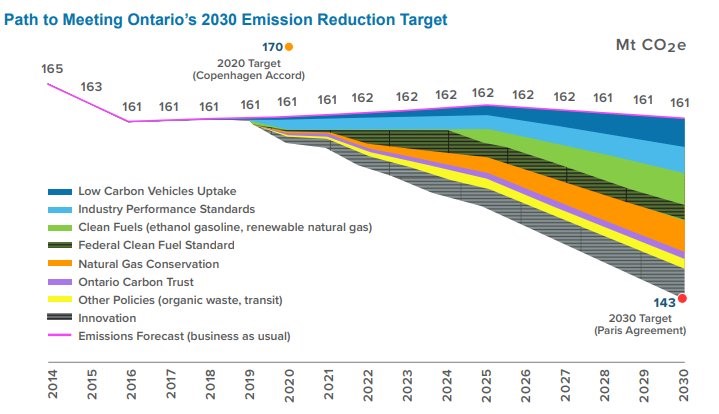November 30, 2018
By Mike Moffatt
The Ontario government has released their climate plan, Preserving and Protecting Our Environment for Future Generations: A Made-in-Ontario Environment Plan. Announced by Environment Minister Rod Phillips, the plan is light on details and appears to weaken climate action in Ontario, precisely when bold leadership is needed to protect the environment and the economy alike.
The Ontario government has substantially weakened Ontario’s 2030 greenhouse gas (GHG) emissions target from 112.9 Mt CO2e to 143.3 Mt CO2e – this means softening our target by close to 27%. The plan contains a chart showing how the provincial government expects to reduce GHG emissions by 18 Mt CO2e between now and 2030, with a portion of those reductions coming from provincial government actions.

The document cites no sources on how it determined these estimates, nor does it show how they were calculated. Taking these figures at face value, here’s how the Ontario government forecasts achieving these emissions reductions:
- The Industrial Performance Standards section (light blue, 15% of the expected reduction) refers to a new proposal for output-based performance standards (OBPS) system for large emitters. Details are still to come about how the system would work, though the plan notes that it “will consider factors such as trade-exposure, competitiveness and process-emissions, and allow the province to grant across-the-board exemptions for industries of particular concern, like the auto sector” and “may include compliance flexibility mechanisms such as offset credits and/or payment of an amount to achieve compliance”.
- Clean Fuels (light green, 19% of the expected reduction) comes, in part, from a clause to “increase the renewable content requirement (e.g. ethanol) in gasoline to 15% as early as 2025 through the Greener Gasoline regulation”. The other part of the reduction comes from “encouraging uptake of renewable natural gas and the use of lower carbon fuels”, though no details are given on what this encouragement might look like. Details are not given on the relative weighting of the ethanol mandate vs. the encouragement in achieving these reductions.
- The Ontario Carbon Trust (light purple) which includes the Ontario Reverse Auction “to encourage private investment in clean technology solutions” and an emissions reduction fund designed to leverage private investment in clean technologies. The government proposes to spend $400 million over 4 years on the Trust, though it is expected to only account for 4% of Ontario’s emissions reduction. Given a stated goal of the overall plan is that "taxpayers should not have to watch their hard-earned dollars be diverted towards expensive, ineffective policies and programs that do not deliver results”, it is surprising to see such a modest emissions reduction forecast attached to a $400 million program.
- Natural Gas Conservation (orange, 18%) “assumes a gradual expansion of programs delivered by utilities, which would be subject to discussions with the Ontario Energy Board”, though no details or timeline are given. Other (yellow, 6%) include investment in public transit and reductions for keeping organic waste from landfill.
- The rest of the reductions come from economic changes that appear unrelated to Ontario government policy (innovation at 15% and low carbon vehicle update at 16%) or are due to federal policy (Federal Clean Fuel Standard at 7%).
The plan pledges to update and report on these estimates “once program details are finalized”. We look forward to further details.
What is needed right now is an overall approach that includes complementary climate and energy efficiency policies, transitional support for affected workers and communities, and measures to drive the innovation, infrastructure, skills and investment needed for Canada to compete and prosper as the global economy shifts to cleaner growth. Governments today have an opportunity to be leaders rather than laggards, by recognizing that the world is moving towards a low-carbon economy as a fundamental economic shift. This issue is neither left-wing nor right-wing, and we need far-sighted policy leadership from our governments today to build a stronger, cleaner economy.

